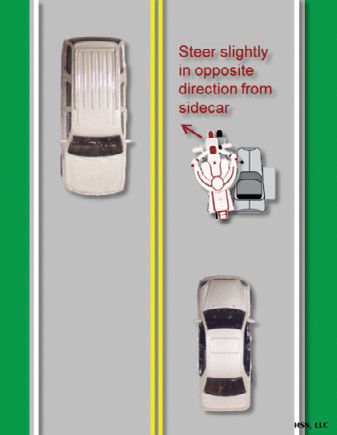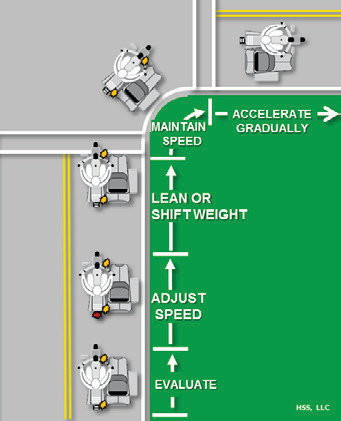
Section 12: Motorcycles with a Sidecar
Section 12: Motorcycles with a Sidecar
This Section Covers
- Stopping – 12.1
- Accelerating – 12.2
- Turning – 12.3
- Stopping Quickly – 12.4
- Carrying Passengers and Cargo – 12.5
12.1 – Stopping

Check your sidecar for brakes. Some sidecars are equipped with brakes while others are not. Your stopping distance and handling will be affected if your sidecar is not equipped with brakes.
You may need to steer slightly in the direction of the sidecar when applying the motorcycle brakes if your sidecar is not equipped with brakes.
12.2 – Accelerating

During acceleration, steer slightly in the opposite direction from the sidecar to maintain a straight line path.
12.3 – Turning
When operating a sidecar-equipped motorcycle, additional consideration needs to be given to the direction of the turn and amount of weight in the sidecar. When turning a motorcycle with a sidecar:
- Evaluate the degree of turn required.
- Adjust speed before the turn to allow you to safely accelerate through the turn.
- Lean or shift your weight in the direction of the turn.
- Maintain speed as you enter the turn.
- Accelerate gradually as you exit the turn.
Turning Left

During a left turn, the sidecar acts as a stabilizer, so the sidecar wheel stays on the ground. However, if the turn is taken too sharply or at too great a speed, it may cause the rear wheel of the motorcycle to lift off the ground and the nose of the sidecar to contact the pavement.
Turning Right

A right turn taken too sharp or at too great a speed may cause the sidecar wheel to lift off the ground. The lift will be greater if the sidecar is empty or lightly loaded. You can avoid this wheel lift by slowing before entering the turn and shifting more of your weight to the inside of the turn, towards the sidecar.
12.4 – Stopping Quickly
Stopping quickly in a straight line is the primary technique for avoiding collisions in traffic. Always, use the front and rear brakes simultaneously, adjusting pressure on the levers to apply maximum braking just short of skidding either wheel. If the front wheel skids, ease off some of the pressure to regain steering control. If the rear wheel skids, keep it locked until the vehicle has stopped completely. If the sidecar wheel has a brake, and that wheel starts to skid, you can safely ignore it.
Making quick stops in a curve is more difficult, especially if the road curves to the right. Hard braking in a curve to the right tends to lift the sidecar, which may require additional weight shift to the right to compensate. Stopping quickly in turns to the left is less dangerous because there is a reduced danger of tipping over. And, if the wheels skid, the vehicle will slide toward the road shoulder, not into the opposing lane of traffic.
12.5 – Carrying Passengers and Cargo
Only skilled, experienced riders should carry passengers or heavy loads. The additional weight of a passenger or cargo will change the handling characteristics of the vehicle.
You must give some thought to where the passengers are seated and the loads are positioned. The best place for a passenger is in the sidecar. Avoid carrying a passenger behind you while leaving the sidecar empty. This could increase your chances for a tip over. If you have two passengers, place the heavier passenger in the sidecar to improve handling. The passenger sitting behind you should sit upright at all times. It is not necessary for the passenger to lean into curves with you. When loaded, your vehicle will need more time and distance to stop. You will need to increase your following distance.
When carrying cargo in a sidecar, it should be centered low, over the sidecar axle and secured firmly in place. If the cargo shifts, handling will be affected.
Test Your Knowledge
- When stopping a motorcycle with a sidecar:
- Steer straight ahead.
- Steer slightly in the direction of the sidecar.
- Steer slightly in the opposite direction of the sidecar.
- When accelerating on a motorcycle with a sidecar:
- Steer straight ahead.
- Steer slightly in the direction of the sidecar.
- Steer slightly in the opposite direction of the sidecar.
- How can you avoid the sidecar wheel lifting off the ground in turns?
- Accelerating before the turn and shifting your weight towards the sidecar.
- Slowing before the turn and shifting your weight towards the sidecar.
- Slowing before the turn and shifting your weight opposite of the sidecar.
- When stopping quickly and the front wheel skids, you should:
- Keep it locked until the vehicle has completely stopped.
- Ease off some of the pressure to regain steering control.
- Hold the handgrips firmly and ease off the throttle.
- Where is the best place for a passenger on a motorcycle with a sidecar?
- In the sidecar.
- Behind the rider.
- In front of the rider.
Answers
- B – see the section "Stopping"
- C – see the section "Accelerating"
- B – see the section "Turning"
- B – see the section "Stopping Quickly"
- A – see the section "Carrying Passengers and Cargo"
Danger: All DMVs are not Alike!
Beware of fake DMV websites that charge for training materials or informational material. Most customers arrive at these sites by doing a browser search for "Georgia DMV," "Georgia License Renewal" or similar generic searches.
Please read the pages of these sites carefully, because by law they are required to inform users that the site is not affiliated with any State or Government Entity. They are privately owned sites that will have .com or .org at the end of their website address (url). The official state of Georgia websites will have .gov as is the case with www.dds.georgia.gov.